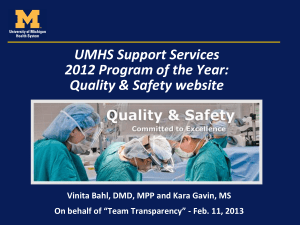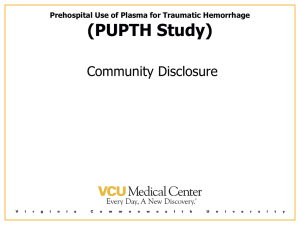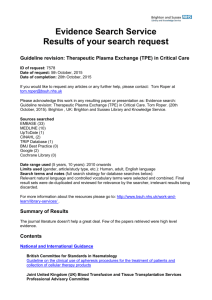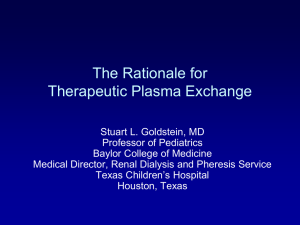血漿分離術
advertisement
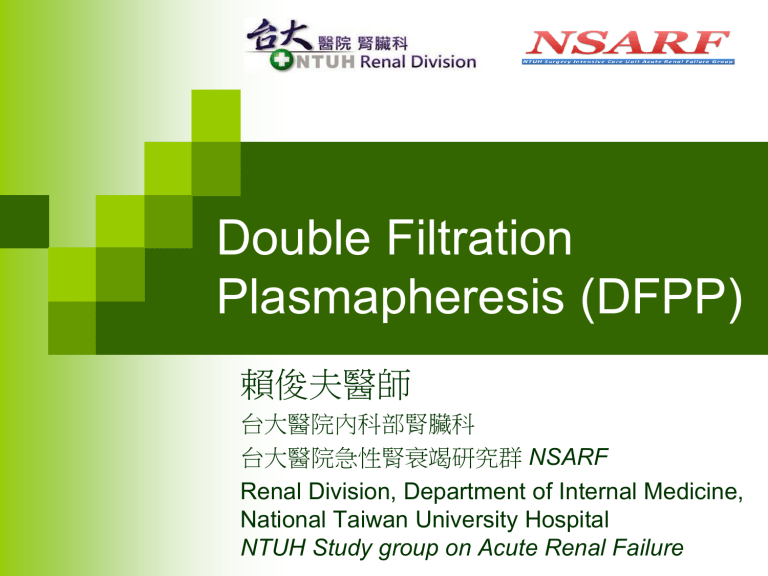
Double Filtration Plasmapheresis (DFPP) 賴俊夫醫師 台大醫院內科部腎臟科 台大醫院急性腎衰竭研究群 NSARF Renal Division, Department of Internal Medicine, National Taiwan University Hospital NTUH Study group on Acute Renal Failure Plasma therapy in CVS (TPE, DFPP, ECP) 賴俊夫醫師 內科部腎臟科 March 25, 2011 血漿治療 Plasma – 血漿 Apheresis – 分離; Exchange – 交換 血漿分離術 (Plasmapheresis) 將血液中血球與血漿分離,以移除血漿中較大 分子量的有害成份 血漿置換術 (Plasma exchange) 將血漿取出體外,去除血漿中的有害物質,再 換以正常人的血漿。 Molecular weight of removed substances by blood purification therapy 離心式血漿分離 補充液 Centrifugal Separation Plasma Exchange 空心纖維膜血漿分離 治療性血漿交換術 (TPE, Therapeutic Plasma Exchange) 輸注他人血漿,以補充移除的血漿 雙重血漿分離術 (DFPP, Double Filtration Plasmapheresis) 利用兩個人工腎臟,減少移除的血漿量 空心纖維膜血漿分離 補充液 補充液 FFP, Plasmanate, Lacted Ringer’s Membrane Separation Plasma Exchange HF-400 Plasmacure TM Plasma seperator (ASAHI KURARAY MEDICAL CO., LTD) Evaflux TM (KURARAY MEDICAL INC.) Plasma fractionator 雙重過濾血漿分離術 補充液 N/S 0.2μm 0.03μm 去除血漿中有害成分(分離 血漿的10%,約血流的3%) KPS-8800Ce 血漿移除量 1 plasma voulem = BW X (1/13) X (1-Hct) Plasma volume Volume exchanged Immunoglobulin exchange( Ve/EPV ) ( Ve, ml ) or other substance eg. 60kg, Hct 40% removed (MRR,%) 0.5 1,400 39 1.0 2,800 63 1.5 4,200 78 2.0 5,600 86 2.5 7,000 92 3.0 8,400 95 血漿補充量 視血漿移除量多寡 Plasma exchange 移除2 plasma volume 5600 cc 血漿 22U FFP + 5 plasmanate + 3 Ringer’s Double filtration plasmapheresis移除量 移除1.5 plasma volume 4200 cc 血漿血漿量 x10% = 420cc 3U FFP, or 500cc Ringer’s, or albumin 血漿補充液之選擇 好處 白蛋白 (雙重血漿分離術) 新鮮冷凍血漿 (血漿分離術) 壞處 較不易感染肝炎 價格昂貴 室溫保存 不含凝血因子 無 不含免疫球蛋白 ABO 血型考量 含凝血因子 較有感染肝炎,愛滋病疑慮 較不易出血 較易發生過敏反應 含免疫球蛋白 需 生理食鹽水 便宜 補充量大時不適用 代用血漿 便宜 半衰期短 ABO-血型相合 治療機轉 血漿移除 血漿輸注 可能的治療機轉 血漿移除 移除血漿中可能的致病因子: TPE, DFPP Antibodies (Anti-GBM Ab disease; MG) Immune complex (SLE) Cryoglobulin (Cryoglobulinemia) Myeloma protein (Myeloma nephropathy( Endotoxin, cytokine (Sepsis) Poison or drug Cholesterol, LDL-c 可能的治療機轉 血漿輸注 補充血中缺乏之因子: TPE only Anti-thrombotic or fibrinolytic factor (HUS/TTP): removal of auto-antibodies to vWF multimers cleaving enzyme + infusion of vWF multimers cleaving enzyme 免疫調控 (Immunomodulation) Removal of complement products (SLE) Effect of immune regulation (Transplantation) Improvement in RE function (cyroglobulinemia) 健保給付之適應症 58008C血漿置換術(2475點) Plasma exchange:限下列病患實施 1.SLE,CNS involvement 2.Myasthenia gravis crisis 3.Macroglobulinaemia 4.RPGN 5.Goodpasture's disease 6.Multiple myoloma 7.Guillain-Barre syndrome 8.Thrombocytopenic Purpura 9.其他經專案向保險人申請同意實施者 58016C二重過濾血漿置換療法(2475點) Double filtration plasmapheresis:施行本項之適應症請依 支付標準58008C「血漿置換術」之規定辦理。 Applications of plasmapheresis ASFA guidelines e.g. SLE lupus nephritis ASFA guidelines Traffic Accident Transfer to NTUH Cardiac echo: LVEF 19% 8/14 8/15 8/16 8/23 VV-ECMO LM dissection s/p POBAS Desaturation PCWP 40 mmHg Dilate LV 8/31 9/1 9/5 9/6 Extubation 9/15 LV Drain Cardiac cath: No ISRS 10/5 LV Assist Device Remove VV-ECMO 10/20 10/25 檢查項目 數值 37℃ B cell 1:32 Positive Negative 37℃ T cell 1:32 Positive Negative 4℃ B cell 1:32 Positive Negative 4℃ T cell 1:32 Positive Negative Donor:楊XX 數值 1:32 Positive 1:32 Positive 1:32 Positive 說明 37℃ 37℃ 4℃ 檢查項目 B cell T cell B cell 4℃ T cell 1:32 Positive Negative 11/3 Panel reactive antibody: Anti-HLA class I: 61% Anti-HLA class II: 72% 標準值 標準值 Negative Negative Negative 說明 Donor:鄭XX Rituximab (Mabthera) 200 mg Bortezomib (Velcade) 3.5 mg Solu-Medrol 1000 mg Intravenous immunoglobulin 45 gm R-anti-thymocyte globulin 25 mg Plasma Exchange Hypotension, Bradycardia 11/3 11/4 11/6 11/8 11/10 11/12 Donor 11/12 檢查項目 數值 標準值 37℃ B cell 1:8 Positive Negative 4℃ T cell 1:2 Positive Negative 說明 Double Filtration Plasmapheresis 37℃ T cell 1:2 Positive Negative 3L/session, 1.2x plasma volume 4℃ B cell 1:4 Positive Negative total 5 course Donor:侍XX Isoproterenol Millisrol Dopamine Primacor (Milrinone) Bosmin 3000 Graft failure ? 2500 CO: 2.23 CI: 1.48 2000 1500 1000 CVVH 500 11/11 11/12 Transplant 11/13 DFPP 11/14 11/15 11/16 Massive bloody pleural effusion DFPP IVIG 11/17 IVIG Solu-Medrol FK506 Cellcept 11/18 11/19 PT PTT sec sec 26.6 39.1 Definition Exposure of the immune system to antigen (transplant organ) sufficient to generate an immune response Antibody ABO Anti-HLA Non-HLA • Blood transfusions • Pregnancy • Previous organ transplant • Placement of a ventricular device Approximate 30% incidence of antibody production (PRA > 10%) after LVAD placement J Heart Lung Transplant 2002; 21: 1218-24 Prevent rejection Humoral Response Donor selection Recipient Desensitization Cellular Response Immunosuppressive agents Human Immunology 2005;66:334-42 Examples of desensitization J Heart Lung Transplant 2009;28:213-25 Pre-heart transplant plasmaheresis for sensitized patients (high PRA) 1.5 plasma volume plasmapheresis + 20g 5% IVIG, then heart transplant 1.5 plasma volume plasmapheresis qod (followed by 20g 5% IVIG )X 5 sessions. Then a single plasmaphereis with IVIG at the time of surgery J Heart Lung Transplant 1999;18:701 Clin Transplant 2006;20:476-84 HLA class I HLA class II Clin Transplant 2006;20:476-84 Clin Transplant 2006: 20: 476–484 On-pump TPE for XM heart transplant High blood flow and thus increased pheresis rate to shorten treatment time than standard setting of TPE/DFPP 3 plasma volume within 60-90min Especially need to watch out [Ca] J Extra Corpor Technol 1999;31:177-83 J Heart Lung Transplant 2008;27:1036-9 Comparative long-term outcome 5-year patient survival 1-year rejection-free survival 523 heart transplant, 95 PRA>10%, 21/95 desensitization, 74 untreated Survival: no significant difference Rejection: significant decrease in desensitized patients (Treated with PP+IVIG+Rituximab) Clin Transplant. 2010 Oct 25 Proposed protocol for desensitization Solumedrol 500mg IVIG 15g (heart lung machine) Bortezomib (Velcade) IV slow push IVIG 30g slowing infusion Solumedrol 500mg + Rituximab (Mabthera) IV drip RATG + FK506 D-9 D-7 D-5 D-3 D-1 OP day D1 D3 D5 TIW 1.5 PV 1.5 PV 1.5 PV 1.5 PV 1.5 PV 1.5 PV 2 PV 1.5 PV 1.5 PV1.5 PV DFPP DFPP DFPP DFPP DFPP DFPP TPE DFPP DFPP DFPP IVIG IVIG IVIG IVIG IVIG (OR) Initial Ab X(1-78%)5 =0.0005 initial amount residual Ab X(1-86%) Extracorporeal photopheresis T-cell B-Cell Primary prophylaxis N Engl J Med 1998;339:1744-51 Clin Transplantation 2000;14:162-6 Secondary prophylaxis J Heart Lung Transplant 2006;25:283-8 Extracorporeal photopheresis (ECP) Leukapheresis-based immunomodulatory therapy. Mechanism: causes apoptosis of the treated and abnormal T cells induces monocytes to differentiate into dendritic cells capable of phagocytosing and processing the apoptotic T-cell antigens may cause a systemic cytotoxic CD8+ T-lymphocyte– mediated immune response to the processed apoptotic T-cell antigens induce antigen-specific regulatory T cells, which may lead to suppression of allograft rejection or GVHD ECP Procedures 3 basic stages: (1) leukapheresis, (2) photoactivation, and (3) reinfusion. The process takes 3-4 hours to complete. Blood (225 mL) is passed through 3 cycles of leukapheresis, or 125 mL of blood is passed through 6 cycles, depending on the patient's hematocrit value and body size. At the end of each leukapheresis cycle, the red blood cells and plasma are returned to the patient. The collected WBCs (including approximately 5% of the peripheral blood mononuclear cells) are mixed with heparin, saline, and 8methoxypsoralen (8-MOP), which intercalates into the DNA of the lymphocytes upon exposure to UVA light and makes them more susceptible to apoptosis when exposed to UVA radiation. The mixture is passed as a 1-mm film through a sterile cassette surrounded by UVA bulbs for 180 minutes, resulting in an average UVA exposure of 2 J/cm2 per lymphocyte. The treated WBC mixture is returned to the patient. UVAR XTS (Therakos, USA) ECP Complications Hypotension may occur in some patients during the collection phase of the treatment. Low-grade fevers, likely due to the release of cytokines. Some patients with cutaneous T-cell lymphoma (CTCL) may experience an increase in pruritus or redness. No immunosuppression, opportunistic infections, or neoplasia has been associated with extracorporeal photopheresis. Acute AMR after heart transplant Anti-B-memory and/or plasma cells agents Am J Transplant 2007;7:2064-74 Transplant Rev 2009;23:34-46 Transplant Rev 2009;23:34-6 血漿分離術之併發症 血管通路 血胸、氣胸、後腹腔出血 抗凝劑 出血 Hypothermia Hyperthermia blanket , Warm lamp, Warmer 血漿分離術之併發症 血漿內成份的移除 血漿量 低血壓、急性心衰竭 (3-6%) 血漿膠體滲透壓降低導致水腫 藥物 Volume distribution 較小者易被移除 酶 Cholinesterase 麻醉藥物代謝減慢 GOT/GPT, LDH, CPK下降 血漿分離術之併發症 血漿輸注 (Plasma exchange) 過敏反應 (5%) 蕁麻疹、氣管痙攣、低血壓、肺水腫 Premedication: antihistamine, steroid 感染 HBV:1/200-1/300 HIV:1/40000-1/1000000 CMV: asymptomatic 低血鈣症 (1%) : Infusion CaCl2 : 2% 20 c.c/hr 冷凍血漿常使用Citrate作為抗凝劑所引起 抽筋、寒顫、嘴部發麻、噁心、心律不整等。 代謝性鹼中毒:Citrate所引起 血漿分離術之併發症 非血漿輸注: 球蛋白流失:感染 凝血因子流失(DFPP):出血 TPE vs DFPP Mechanism TPE: Plasma removal + plasma infusion DFP: Plasma component removal Indication DFPP: not suitable for Hepatic failure, TTP/HUS, refractory bleeding problems Complication – 較常見, besides=>exposure to more antigens DFPP – 凝血因子缺乏 TPE Treatment Disease Product Option 1 Option 2 ABO-mismatched renal transplantation DFPP PE Cascadeflo Plasmaflo Allogenic renal transplantation DFPP PE Cascadeflo Plasmaflo Rapidly progressive glomerulonephritis (RPGN) DFPP PE Cascadeflo Plasmaflo Henoch-Schulein purpura nephritis DFPP PE Cascadeflo Plasmaflo Systemic lupus erythematosus (SLE) IA DFPP Immusorba Cascadeflo Arteriosclerosis obliterans (ASO) DFPP Cascadeflo Plasmaflo Focal glomerulosclerosis DFPP Cascadeflo Plasmaflo Acute renal failure CRRT CUREFLO Disease Treatment Product Option 1 Option 2 Systemic lupus erythematosus (SLE) IA DFPP Immusorba Cascadeflo Rheumatoid arthritis (RA) with vasculitis IA DFPP Immusorba Cascadeflo Disease Treatment Option 1 Option 2 Product Arteriosclerosis obliterans (ASO) DFPP Cascadeflo Plasmaflo Familial hypercholesterolemia (FH) DFPP Cascadeflo Plasmaflo Asahi Kasei Kuraray Medical Co., Ltd. Disease Treatment Option 1 Acute renal failure(ARF) CRRT Fulminant hepatitis (FH) CRRT Hemolytic uremic syndrome (HUS) PE Disease Product Option 2 CUREFLO PE CUREFLO Plasmaflo Plasmaflo Treatment Product Option1 Option 2 Myasthenia gravis(MG) IA DFPP Immusorba Cascadeflo Guillain-Barr? syndrome (GBS) IA DFPP Immusorba Cascadeflo Chronic inflammatory demyelinating =olyneuropathy(CIDP) IA DFPP Immusorba Cascadeflo Multiple sclerosis (MS) IA DFPP Immusorba Cascadeflo Lambert-Eaton myasthenic syndrome(LEMS) PE Miller-Fisher syndrome(MFS) IA Plasmaflo DFPP Immusorba Cascadeflo Asahi Kasei Kuraray Medical Co., Ltd. Disease Treatment Option 1 Product Option 2 Pemphigus DFPP PE Cascadeflo Plasmaflo Pemphigoid DFPP PE Cascadeflo Plasmaflo Toxic epidermal necrolysis (TEN) DFPP PE Cascadeflo Plasmaflo Systemic sclerosis (SS) IA DFPP Immusorba Cascadeflo Disease Treatment Product Option 1 Option 2 Multiple myeloma DFPP PE Cascadeflo Plasmaflo Primary macroglobulinemia DFPP PE Cascadeflo Plasmaflo Thrombotic thrombocytopenic purpura (TTP) DFPP PE Cascadeflo Plasmaflo Hemophilia PE Cryoglobulinemia DFPP Disease Age-related macular degeneration(AMD) Plasmaflo PE Treatment Option 1 DFPP Option 2 Cascadeflo Plasmaflo Product Rheofilter Plasmaflo Asahi Kasei Kuraray Medical Co., Ltd. Disease Treatment Option 1 Product Option 2 Ulcerative colitis (UC) LCAP Cellsorba Crohn's disease (CD) LCAP Cellsorba Severe acute pancreatitis CRRT CUREFLO Post-operative hepatic failure CRRT Acute hepatic failure CRRT CUREFLO Primary biliary cirrhosis PA Plasorba Hyperbilirubinemia PA Plasorba Fulminant hepatitis CRRT Chronic hepatitis C DFPP PA CUREFLO PE Plasorba CUREFLO Plasmaflo Cascadeflo Plasmaflo Treatment Disease Severe blood-type incompatible pregnancy Disease Sudden sensorineural hearing loss (SSHL) Option 1 Option 2 DFPP PE Treatment Option 1 DFPP Option 2 Product Cascadeflo Plasmaflo Product Rheofilter Plasmaflo Asahi Kasei Kuraray Medical Co., Ltd. Flow limitation of TPE/DFPP 300X40%=120cc/m=7.2L/hr => 3 plasma volume in 70mins 150X30%=45cc/m=2.7L/hr≒1 plasma volume/hr 200X30%=90cc/m=5.4L/hr=> 2 plasma volume in 60+mins Qb 50-150cc/m Plasma flow ≦40% Qb MaxTMP 100mmHg 補充液 N/S MaxTMP 50mmHg Waste fluid flow ≦30% plasma flow Summary Plasmapheresis is a rational therapy for AMR and sensitized candidates, while the solid evidence is still lacking. Both TPE and DFPP could offer the ability of removing circulating antibody. DFPP may decrease the risk of antigens exposure and complications from blood component infusion (hypocalcemia, allergic reaction…) No well-defined standard protocol and we could developed our protocol Rate of plasma flow may be the main limitation Thanks for your attention! 賴俊夫醫師 MVPN: 51652 E-mail: s821052@yahoo.com.tw Better choice: MARS or Prometheus Other choice: TPE + CVVHDF 合併使用 IVIG 須待血漿置換術後再給予, 以免血漿置換術時遭移除 Renal transplantation 70’-80’ CR/CS: effective for all rejection 80’ RCT: not effective, even in so called “vascular pathology” Since late 80’: DSA, C4d, development of Banff criteria, better anti-rejection medications -> effective for AMR Since 90’: AMR: removing circulating DSA Pretransplant incompatible graft: desensitization of donor specific HLA or ABO antibody Renal transplantation uncertainties Lack multi-center randomized controlled trial New methods for detecting XM antibody higher laboratory sensitivity clinical specificity ? Criteria for desensitization XM methods: cytotoxic DSA detection XM, flow XM C4d deposition Quantification of antibody, threshold? ABO, MHC class I, class II ? DR ? DP,DQ? Others?




